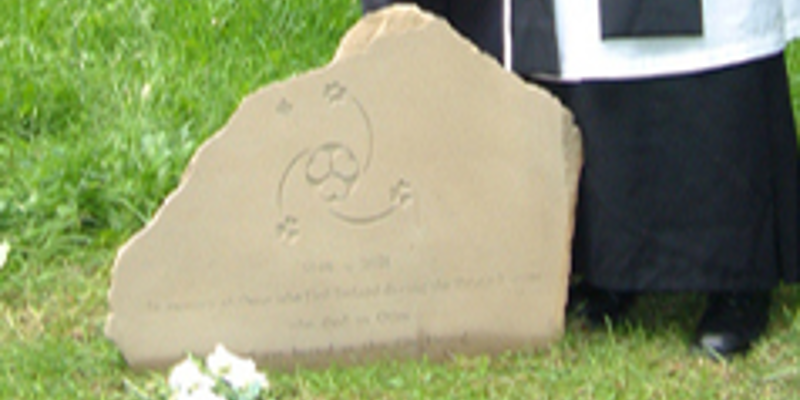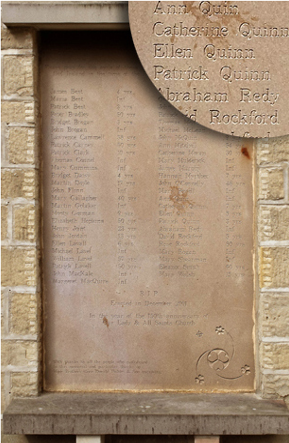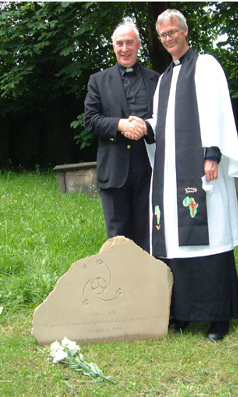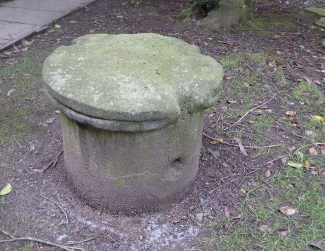Two Churchyard Memorials

Margaret Parkin looks at some memorials in the churchyard
I wonder how long it is since you had a look around the churchyard – maybe you have never have! Well, here are a couple of stories to encourage you to go and see for yourself sometime soon. Do tread carefully though!
Reading the memorial stones will give you a fascinating glimpse of Otley life before 1861 when the graveyard was closed, and burials were then held in the Pool Road Cemetery.
The importance of the humble potato
Our first story has its origins in Ireland. Owing to the failure of the potato crop, there was a great famine there in 1845. Otley was inundated by some hundred Irish families, invited
here by Thomas Constable who lived in the Manor House. The families initially settled in tents on what became known as the Irish Fields, somewhere in the area we now call the Cambridge Estate. Many of them arrived weakened by starvation after their long journey. Lots of them had famine related diseases. The young in particular suffered, with many of them dying soon after they arrived here.
The Parish registers name some 79 Irish people buried in our churchyard between 1845 and 1860, there being no consecrated ground in the town for Catholic burials. Among them were 23 infants. The oldest person was Francis Blisset, aged 84. He died as a result of being murdered by his nephew’s wife!
The Telegraph and Argus told the story of John McQuinn, aged 9 who died of Smallpox the day after his family arrived in Otley in 1847. At his funeral his father carried the foot of the coffin, with a brother and sister on either side at the head. His mother followed on behind. It was claimed there had never been a funeral of its kind in Otley There were no other mourners, only the McQuinn family trudging up the road dressed in rags.
 John is one of those buried in our churchyard. The then vicar, the Revd. Joshua Hart agreed to the burials of the Catholics there – quite a remarkable ecumenical gesture for the time.
John is one of those buried in our churchyard. The then vicar, the Revd. Joshua Hart agreed to the burials of the Catholics there – quite a remarkable ecumenical gesture for the time.
In 2001, the church of Our Lady and All Saints in Otley celebrated its 150th anniversary and decided to create the Irish Famine Memorial. Pictured here, this can be seen on the south wall of the church in Bridge Street. The stone was designed by Peter Holt, donated by Mone Brothers; Pickles Funeral directors undertook the engraving.

The following year, Father Tom O’Connor, Parish Priest of Our Lady and All Saints, and the Rev. Graham Buttanshaw, Vicar of the Parish Church, dedicated a stone in the Parish churchyard to commemorate the burial there of those named on the Famine Memorial.
This stone was also designed by Peter Holt. It’s made of Caen stone and was also given by Mone Brothers and engraved by Pickles Funeral Directors.
It stands in the top west end of the churchyard – in the wildflower garden. To find it, cross the path from the north door of the church, turn left into Church Lane and peep through the railings. And remember them next time you have your Shepherd’s pie!
Chris Power MBE, has written much more about this story – see “Thomas Constable and the Irish in Otley”.
Just opposite the Church North Door lies this object
 Because of its location visitors occasionally ask what it was, and why is it there?
Because of its location visitors occasionally ask what it was, and why is it there?
It has no connection with the church interior or exterior, nor is it the base of a pillar, nor the lower part of a churchyard cross.
Supposedly, it had earlier connections with the town market which is often referred to as the “Buttercross”. Fred Morrell, a former church reader and local historian, believes that this stone was part of a structure which supported a bell, held in position by three vertical bars fitted into the three cutaway parts of the stone rim and soldered into the indents below.
Otley market was granted a royal charter c.1220 and like many markets boasted a Buttercross – a structure built for folks from the outlying villages to come to market to sell their home-produced goods – milk, eggs and, of course, butter. Otley’s was situated in the area that we call the Buttercross – the shelter beside the Jubilee lock in the Market Place.
In market towns, a clerk of the market was appointed to ensure fair and just weights. He was also in charge of the bell and no market could begin or end until he rang it.
When the town’s Jubilee clock was erected it was placed in a position where it could easily be seen from the Market Place and Manor Square. It is reasonable to suppose that the bell stood in that area where it could be clearly heard in the Market Place and where produce and foods were sold, and in the Cattle Market in Manor Square where the sale of livestock took place.
The location of the Jubilee clock was decided in 1881 so it may well be that the bell and its structure was taken down somewhere between 1883 and 1885.
In 1883 Thomas Constable, a solicitor and Deputy Steward of the Manor of Otley, retired and was succeeded by Henry Dacre. It is thought that when the market bell was taken down he took charge of the bell and the stone. The bell was put into his office in the old Manor Grammar School in Manor Square which lay forgotten for many years. Fred Morrell remembers seeing a photograph of the bell with the date 1767 engraved on the rim.
It is probable that Fred removed the stone to his garden at the house called “Hawthornden” on Bradford Road and that it was later placed in the churchyard when he moved to Caley Hall at the turn of the 19th century.
Fred Morrell’s story finishes with a question – “Can it be proved that the bell is connected with the stone – and did they once comprise the Market Bell?”
As yet, the question is unanswered, so for now we will simply enjoy the story.